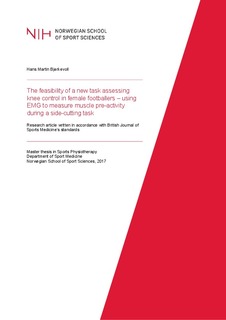| dc.description.abstract | Screening tasks for assessing risk of anterior cruciate ligament (ACL) injury cannot predict injuries, and more challenging tasks for assessing knee control in athletes should be examined. Neuromuscular assessments of knee control are thought to play a critical role in the prevention of ACL-injuries, but few studies have investigated tasks other than vertical drop jump and side-cut manoeuvres. A new task aiming to replicate side-step movements seen in ACL-injury situations in football matches was developed. The objective of this study was to determine the feasibility of a task developed for assessing knee control in female footballers. It was examined if electromyography (EMG) could successfully be recorded during the new task, and whether EMG pre-activation would undergo clinically relevant changes as a function of ball release frequency and visual stimulus. A repeated measures experimental study was designed, with 16 female footballers with no history of ACLinjury as participants. EMG pre-activation (50ms prior to initial contact) for the semitendinosus (ST), vastus lateralis (VL), gluteus medius (GMED), and gluteus maximus (GMAX) was recorded during a task with multiple change-of-directions that mimicked situations in football matches where a defender is pressing an attacker. Participants reacted to a table tennis ball being launched, with a cutting motion to stop the ball with their feet. Comparisons between conditions with visual stimulus (VS) and without visual stimulus (NOVS) were made in the unanticipated task. EMG pre-activation could not be captured successfully for all the GMED or GMAX during the task. EMG-data from the VL could be obtained from 397 cuts (36.1%). The ST had valid data from 266 cuts (24.6%). A trend for lower EMG pre-activation of the ST was seen in the VS condition compared to the NOVS condition. The ST was the only muscle with statistically significant decreased EMG pre-activation in the VS condition in the two easiest difficulty levels. No other statistically significant differences as a function of ball release frequency and visual stimulus were seen. | nb_NO |
